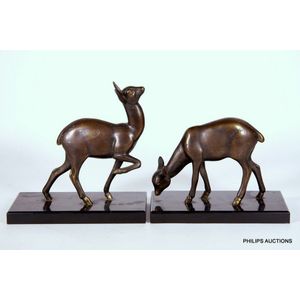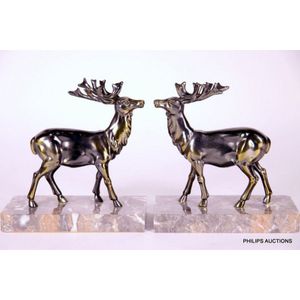Art Deco Stag Bookends
You must be a subscriber, and be logged in to view price and dealer details.
Subscribe Now to view actual auction price for this item
When you subscribe, you have the option of setting the currency in which to display prices to $Au, $US, $NZ or Stg.
- Art Deco Period - The Art Deco period was a cultural movement that emerged in the 1920s and 1930s, and was characterized by its emphasis on modernism, luxury, and elegance. The name "Art Deco" comes from the Exposition Internationale des Arts Décoratifs et Industriels Modernes, a large exhibition held in Paris in 1925 that showcased the latest trends in decorative arts.
Art Deco was a reaction against the ornate and elaborate styles of the previous era, and reflected a new modern sensibility. It was characterized by streamlined, geometric shapes, bright colours, and the use of new materials such as chrome, glass, and Bakelite. Art Deco designers sought to create a sense of luxury and sophistication, often incorporating expensive materials such as ivory, marble, and rare woods.
Art Deco had a significant impact on a wide range of artistic fields, including architecture, fashion, graphic design, and interior design. Some of the most iconic examples of Art Deco architecture include the Empire State Building in New York City, the Hoover Building in London, and the Palais de Chaillot in Paris.
The Art Deco period came to an end in the 1940s, as World War II and changing cultural trends led to a shift in artistic styles. However, Art Deco remains an important influence on design and art, and continues to be celebrated for its modernist sensibility and glamorous aesthetic. - Circa - A Latin term meaning 'about', often used in the antique trade to give an approximate date for the piece, usually considered to be five years on either side of the circa year. Thus, circa 1900 means the piece was made about 1900, probably between 1895 and 1905. The expression is sometimes abbreviated to c.1900.
This item has been included into following indexes:
Visually similar items

An Art Deco Lustred spelter Panther group on a marble and onyx base, circa 1930s, a pair of walking panthers, one growling, in chocolate and gold lustre colours upon a long rectangular base in yellow ochre and brown onyx colours trimmed with cream onyx and

A pair of Art Deco spelter and marble deer bookends, circa 1930s, the pair, one grazing, the other alert, in bronzed colours upon black marble bases with rounded edges, height 20 cm, width 20 cm, depth 10.5 cm

Rochard, R (working 1930s), the Art Deco spelter sculpture of two impala posed naturalistically upon a green above and brown agate base; engraved signature lower right to base. Height 42.5 cm. Width 54.5 cm. Depth 15.5 cm

A French deer figure on oval marble base, 37 cm high, 47 cm long
